How to clean your Bosch geyser with your own hands: care guide + valuable tips
Poor water heater performance interferes with normal life, right? Water barely pours or heats up for a long time, the burner smolders a little or pours soot ... It is necessary to somehow repair it, look for the craftsman, negotiate the price terms. And why spend money if cleaning the heater is easy to do on its own?
We will tell you how to clean your Bosch geyser with your own hands without contacting gas workers. To completely disassemble and clean the device, a “home” set of tools is enough. You will learn all about dismantling the working blocks of the column, the rules for cleaning its burner, heat exchanger and chimney from our article.
The content of the article:
What pollutes the Bosch geyser?
Causes of pollution instantaneous water heater related to its functions and principle of action:
- Flowing water.The column heats the flow of water flowing through its heat exchanger, which brings with it mineral inclusions. As a result, the clogging deposit settles on the walls of the heat exchanger and the pipes of the device and gradually increases.
- Gas burner. In case of defective gas combustion (see reasons below), soot and soot are formed. The latter clogs the fins of the heat exchanger and the chimney, further deteriorating the combustion of gas fuel and slowing down the heating of water.
- Poor quality tap water. Due to the stiffness of tap water during its heating, salts are released from the composition, which are deposited in the form of scale inside the pipes and the heat exchanger. The thicker the scum layer, the narrower the lumen of the pipe and the worse it passes water.
In addition to the magnesium and calcium salts dissolved in the water, it contains mechanical impurities from rusting pipes. They also participate in the gradual overgrowing of the pipe channel in the heat exchanger together with scale.
As for soot, its active formation is promoted by increased pressure on the burner, weak chimney draft (low height, cracks, lack of thermal insulation, etc.), lack of supply air (pvc windows are tight, but there is no supply valve).
The deposition of soot is also facilitated by the use of forced exhaust in a room with a running water heater (causes a lack of oxygen), dustiness of the room (dust enters the burner, which does not cause complete gas combustion).
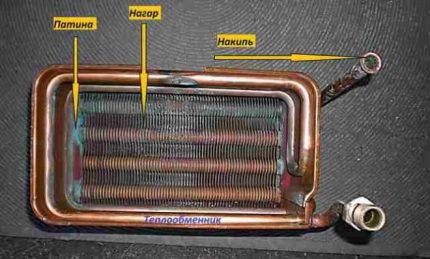
Since scale formation is more intense when water is heated above 60aboutC, some owners of German water heaters set a low burner heating temperature. However, as a result of this, the working cavities of the heat exchanger gradually overgrow with a greenish bloom from condensate.
As a result, the removal of flue gases deteriorates, which contributes to the accelerated formation of soot. A heat exchanger clogged with soot heats water very badly - soot is a good heat insulator.
Signs of gas heater clogging
The need for cleaning the Bosch flowing gas column is determined by the decrease in the operability of the device.
Cleaning is required if:
- the water heater simply does not start;
- it turns on, but does not work for long and turns off on its own, while there is no shortage of water and gas;
- the column heats up properly, but the water heats up noticeably worse than before;
- water pressure at the outlet of the heating device is weaker than at the entrance to the heat exchanger;
- Frequent activation of the overheating sensor, although the water heater is operating under medium load.
Ignition nozzle blockage. Kindle is not possible or it is difficult if the pilot jet is clogged, which is why the device ignites the fuel with a delay - with a characteristic pop. A sign of fuse ignition is a weak yellow wick, although it should be blue.
Soot in the chimney. If the burner ignites, but extinguishes almost immediately after ignition, the smoke channel of the water heater is dirty. The chimney passability is significantly reduced due to soot and soot deposits accumulated over the years of using the column. However, the chimney of the columns in apartments is more often polluted with volatile debris.
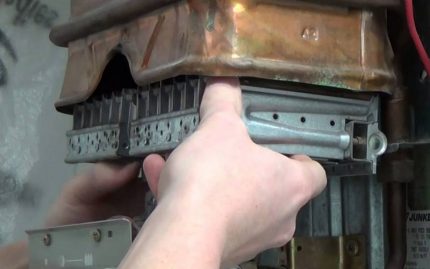
Weak air supply. For natural draft even in a small gas water heater supply air is necessary. And modern homes are equipped with airtight window and interior door blocks.
Solve the problem of insufficient traction will allow ventilation valves that are built into the window frames, wall inletsas well as ventilation grilles in the interior doors.
Scale in the heat exchanger. Inadequate heating of the water in the flowing gas heater causes a reduced flow area of the heat exchanger pipe caused by a layer of scale. And the more limescale has grown, the lower the water pressure after heating in the column against the background of normal pressure at the inlet to the heater.
Soot overgrowth. The greatest amount of soot accumulates in the central part of the finned heat exchanger, transferring heat to running water and contributing to overheating of the side sections of the heat exchange unit.
Uneven heating of the heat exchanger causes the overheating sensor to respond quickly. Most often, soot pollution of fins develops together with chimney clogging.
How to remove the casing of a Bosch water heater?
The decorative and protective casing of the column is easy to remove:
- you need to unfasten the round adjustment knobs by pulling them towards you;
- move the rectangular gas adjustment knob to the body cavity (the “ignited” position). Note that not every Bosch water heater model has such a handle;
- Use a Phillips screwdriver to unscrew the two screws securing the casing to the column frame. They are located below, on the sides of the device.
It remains with both hands to gently push the bottom of the casing of the water heater toward you. Then lift up, completely remove and set aside. Now you can visually assess the contamination of the device, determine the scale sewage treatment.
How to remove and clean the igniter?
Evidence of contamination of the ignition tube: the flame of the ignition spontaneously extinguishes; a weak flame tongue rises upward without shifting to the burner due to insufficient gas pressure (if the pressure of the main or balloon gas has weakened, then the igniter has nothing to do with it).
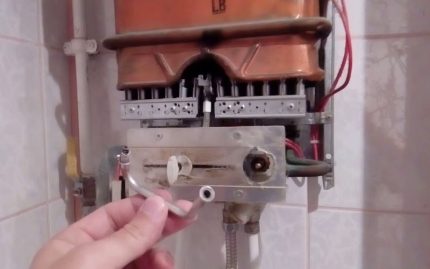
Please note: before you start cleaning the clogged igniter of a Bosch geyser, be sure to double-check that the gas valve of the appliance is closed!
Necessary tools: a flat (minus) screwdriver or thin pliers with curved “lips” (platypuses). Remove the ignition tube carefully enough without pushing through the jacket of the heat exchanger.
The order of dismantling the ignitor of the water heater:
- Upper end. Pull up the bracket holding the flared edge of the ignition tube at the end of the burner. Slightly unclip the bracket, then slide it up with platypus pliers or pry it with a screwdriver until it is completely removed;
- Lower end. It is necessary to squeeze the edges of the bracket fixing the igniter;
- Removing the igniter. Having freed the ends of the tube, it remains to lift it up and remove it with a movement “towards itself”.
To clean the cavity of the ignition tube, you will need a piece of not too rigid wire, on which a piece of lint-free cloth is clamped (for example, microfiber cloths). We stretch a home-made "brush" inside the tube, then lightly tap it and blow it.
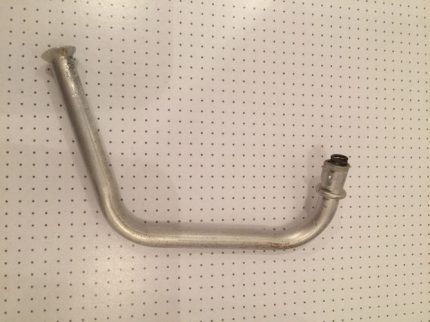
It is also necessary to clean the tungsten spring on the underside of the tube. This will provide a quick ignition from the piezoelectric element. Finally, it is required to clean the nozzle at the lower point of connection of the ignition tube and the electrode located in front of the upper outlet of the tube. They should be wiped with microfiber or other lint-free cloth.
The installation in the column of the cleaned igniter is carried out in the reverse order of dismantling. If cleaning is performed efficiently, then the flame from a lit ignition tube will be almost invisible.
Cleaning the Bosch Geyser Heat Exchanger
If, after removing the casing of the heater and inspecting the heat exchanger unit, soot contamination is detected, it will need to be dismantled and completely flushed. It is necessary to clean the smoked heat exchanger by removing it from the gas column.
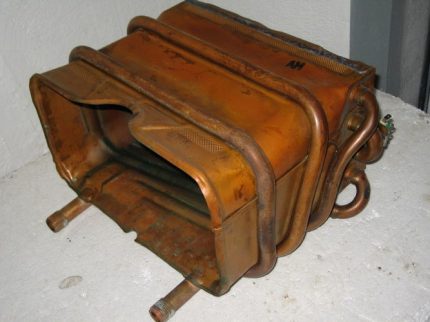
The first step is to close the shut-off valves for water and gas supply to the heating column. If you intend to completely remove the device and dismantle the heat exchanger by placing the column on the table (it will be more convenient) - disconnect the power supply gas hose, water inlet and outlet, then remove the device from the mounts.
However, there is no need to completely remove the water heater; you can remove the radiator of the heat exchange module at the installation site. Consider this maintenance option in detail.
Dismantling the water heat exchanger
The necessary tools are flat (minus), Phillips (plus) screwdrivers and platypus pliers.

Attention: for externally large size the heat exchanger is hollow inside and light. When disassembling, handle it carefully, otherwise remember the side!
The procedure for extracting a heat exchanger using the example of Bosch WR13-2B:
- Overlap shut-off tap of cold water at the feed to the water heater;
- Removing the column cover. Pull out the adjustment knobs by pulling it toward you, unscrew the two self-tapping screws on the sides at the bottom of the case, slide the lower part of the casing towards you, lift and remove from the upper hooks;
- Pulling the bracket securing the tube to the water distribution unit. Pry off the bracket with a screwdriver, remove it with the "platypus", move the tube to the right. Before removing the locking bracket, substitute a wide container under the drain for about a liter of water from the heat exchanger;
- Removing the sensor terminals from the heat transfer tank and housing. Located on the left side of the device, wires go to them;
- Pulling the staples fixing the water supply pipe at the inlet to the heat exchanger (located to the right under it). The principle is the same - to pry off with a screwdriver, carefully pull out with platypus pliers, then remove the tube completely;
- Removing the protective screen in front of the ignition group by unscrewing two screws with a Phillips screwdriver. After you need to remove the ignition group from the nest, remove it;
- Pulling the bracket from the union hose at the outlet of the heat exchanger radiator (screwdriver and platypus), disconnecting the hose. Do not forget to drain the water first by opening the tap on the sink;
- Unscrewing two screws securing the main burner on the sides;
- Unscrewing two screws securing the gas manifold under the burner (located under it, in the center);
- Removing the guide rail holding the heat exchanger from above. There are two side screws for a Phillips screwdriver. Unscrew and remove the bar.
It remains only to remove the heat exchanger with the burner. Place your palms of your hands under the burner on its sides and firmly, not without unnecessary efforts, press the shell of the heat-exchange radiator with your thumbs. Lift them up, then slide the upper part of the heat exchanger “towards you” and remove both modules to the outside.
Cleaning the heat exchanger and main burner
For cleaning and flushing, the heat-exchange radiator must be placed in a bath or other container of suitable size. In order not to scratch the bottom and walls of the bathroom bowl, you should first lay a cloth in it.
Using ordinary detergents, hot water and a long-brushed brush, rinse off the soot from the inside and outside of the unit. Before reassembling into a column, it must be dried.
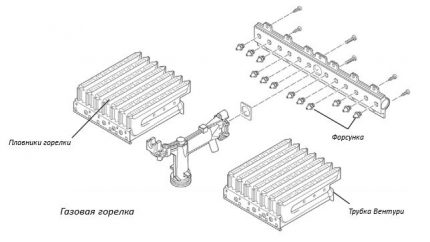
If the burner is soiled with soot, then it must be disassembled and cleaned. The fasteners of the burner sections (Venturi tubes) are bolted; they are easy to unscrew.
Professional cleaning of a dusty burner is carried out with compressed air, and at home - with a soft brush and a vacuum cleaner. In case of serious contamination, wash with soapy water and wipe with a lint-free cloth, then dry and reassemble the burner.
Descaling process
To eliminate deposits of magnesium and calcium salts (scale) in the pipe of the heat exchange radiator, it will be necessary to remove it and prepare it for washing with an acid-containing solution. Note that soot must be cleaned before descaling.

Do not attempt to tear or scale inside the copper tube of the heat exchanger! Firstly, this is an almost useless activity, becausethe bulk of the mineral deposits in the depth of the pipe will be unattainable for stripping. Secondly, scratching the thin walls of the tube will weaken its strength and cause deformation.
The following tools will help remove scale in the column:
- Limescale preparationssold in hardware stores. The procedure for preparing each product for flushing operations is indicated in the manufacturer's instructions;
- Lemon acid. Since the volume of the tube in the design of the heat exchanger is about a liter (the exact volume is indicated in the instructions for the device), you will need to prepare a hot solution in the proportion of 100 g of citric acid per 0.5 l of water in a volume of 700-800 ml;
- Nine percent vinegar. Vinegar diluted in three parts of warm water is able to remove scale in the column heat exchanger. The required volume of solution is 700-800 ml.
No other means such as Coca-Cola or home-made solutions based on active acids (hydrochloric, nitric, sulfuric, etc.) can be used for descaling - soda will not work, and acid solutions can damage the tube.
It is necessary to turn the heat exchanger with the radiator plates down and the I / O of the tube up, insert a funnel into the tube and pour the prepared cleaning solution. Chemical descaling will take several hours, therefore it is more convenient to fill the solution with a heat transfer radiator from evening to morning.
If the column that has been regularly used for several years has not been descaled before, then the mortar cleaner must be changed two to three times until it is completely cleaned. Otherwise, the scale layer, although reduced, will not be completely eliminated.
After waiting for the period necessary for the destruction of scale deposits (more than 4 hours), it is necessary to pour out a cleaning agent and rinse the tube with a large volume of clean water. During the flushing process, it is important to bring out all fragments of the sludge separated from the pipe walls.
He will introduce you to the causes of water overheating by the column and ways to fix the problem next article, which is worth reading to all independent home masters.
Conclusions and useful video on the topic
Step-by-step dismantling of the Bosch water heater for cleaning the heat exchange unit and the main burner:
Video about cleaning the dusty main burner of the column from the home master:
It is necessary to clean the gas water heater from soot and scale every two years of operation, otherwise the performance of the device will sharply weaken. If the warranty period agreed upon by the manufacturer has expired, it is not necessary to contact the gas service with which a contract has been concluded for servicing the equipment.
It happens that there is no particular need to involve gas workers in descaling and carbon deposits. In this case, only male hands, free time and a simple tool are needed. Follow the instructions above and you will succeed!
Want to talk about how to clean your own gas column yourself? It is possible that the subtleties of the cleaning process known to you will be useful to site visitors. Please leave comments in the block below, post photos and ask questions about the topic of the article.

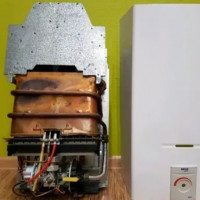 Do-it-yourself vector gas column repair “Vector Lux”: common breakdowns + tips for fixing them
Do-it-yourself vector gas column repair “Vector Lux”: common breakdowns + tips for fixing them 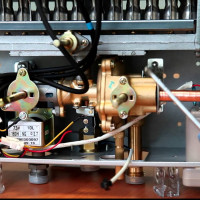 DIY gas heater setup and repair: a guide for water heater owners
DIY gas heater setup and repair: a guide for water heater owners 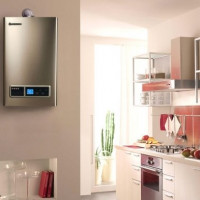 How to choose a geyser: guidelines for choosing and rating the best models
How to choose a geyser: guidelines for choosing and rating the best models 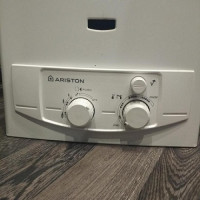 How to light an Ariston geyser: features of inclusion and safety measures when using
How to light an Ariston geyser: features of inclusion and safety measures when using 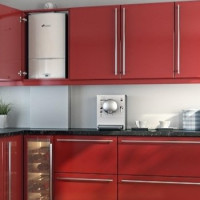 How to hide a geyser in the kitchen: the best ways to disguise + safety requirements
How to hide a geyser in the kitchen: the best ways to disguise + safety requirements 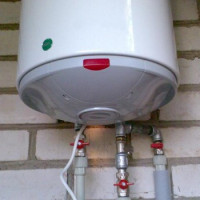 Do-it-yourself water heater installation: a step-by-step guide + technical standards
Do-it-yourself water heater installation: a step-by-step guide + technical standards  How much does it cost to connect gas to a private house: the price of organizing gas supply
How much does it cost to connect gas to a private house: the price of organizing gas supply  The best washing machines with dryer: model rating and customer tips
The best washing machines with dryer: model rating and customer tips  What is the color temperature of light and the nuances of choosing the temperature of the lamps to suit your needs
What is the color temperature of light and the nuances of choosing the temperature of the lamps to suit your needs  Replacement of a geyser in an apartment: replacement paperwork + basic norms and requirements
Replacement of a geyser in an apartment: replacement paperwork + basic norms and requirements